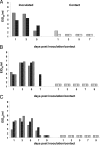Lack of transmission of H5N1 avian-human reassortant influenza viruses in a ferret model
- PMID: 16880383
- PMCID: PMC1567706
- DOI: 10.1073/pnas.0605134103
Lack of transmission of H5N1 avian-human reassortant influenza viruses in a ferret model
Abstract
Avian influenza A H5N1 viruses continue to spread globally among birds, resulting in occasional transmission of virus from infected poultry to humans. Probable human-to-human transmission has been documented rarely, but H5N1 viruses have not yet acquired the ability to transmit efficiently among humans, an essential property of a pandemic virus. The pandemics of 1957 and 1968 were caused by avian-human reassortant influenza viruses that had acquired human virus-like receptor binding properties. However, the relative contribution of human internal protein genes or other molecular changes to the efficient transmission of influenza viruses among humans remains poorly understood. Here, we report on a comparative ferret model that parallels the efficient transmission of H3N2 human viruses and the poor transmission of H5N1 avian viruses in humans. In this model, an H3N2 reassortant virus with avian virus internal protein genes exhibited efficient replication but inefficient transmission, whereas H5N1 reassortant viruses with four or six human virus internal protein genes exhibited reduced replication and no transmission. These findings indicate that the human virus H3N2 surface protein genes alone did not confer efficient transmissibility and that acquisition of human virus internal protein genes alone was insufficient for this 1997 H5N1 virus to develop pandemic capabilities, even after serial passages in a mammalian host. These results highlight the complexity of the genetic basis of influenza virus transmissibility and suggest that H5N1 viruses may require further adaptation to acquire this essential pandemic trait.
Conflict of interest statement
Conflict of interest statement: No conflicts declared.
Figures


References
-
- Subbarao K., Klimov A., Katz J., Regnery H., Lim W., Hall H., Perdue M., Swayne D., Bender C., Huang J., et al. Science. 1998;279:393–396. - PubMed
-
- World Health Organization . Epidemic and Pandemic Alert and Response: Pandemic Influenza. Geneva: W.H.O.; 2006.
-
- Ungchusak K., Auewarakul P., Dowell S. F., Kitphati R., Auwanit W., Puthavathana P., Uiprasertkul M., Boonnak K., Pittayawonganon C., Cox N. J., et al. N. Engl. J. Med. 2005;352:333–340. - PubMed
MeSH terms
LinkOut - more resources
Full Text Sources
Other Literature Sources
Medical

